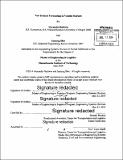New product forecasting in volatile markets
Author(s)
Baldwin, Alexander (Alexander Lee); Shin, Jaesung
DownloadFull printable version (4.003Mb)
Other Contributors
Massachusetts Institute of Technology. Engineering Systems Division.
Advisor
Shardul Phadnis.
Terms of use
Metadata
Show full item recordAbstract
Forecasting demand for limited-life cycle products is essentially projecting an arc trend of demand growth and decline over a relatively short time horizon. When planning for a new limited-life product, many marketing and production decisions depend on accurately predicting the life cycle effects on product demand. For products with stable market shares, forecasting demand over the life cycle benefits from the high degree of correlation with prior sales of similar products. But for volatile-share markets, rapid innovation continually alters the shape of available features and performance, leading to products with demand patterns that differ greatly from prior generations and forecasting techniques that rely more on judgment and naive expectations. In an effort to understand opportunities and limitations of quantitative forecasting in a specific volatile-market context, we hypothesized certain characteristics about the shape and volatility of the demand trend in volatile-market product, and tested them using sample stable and volatile market data from a partner firm. We found significant differences in quantifiable characteristics such as skew and variance over the life cycle, presenting an opportunity for supply chain stakeholders to incorporate life cycle effects into forecasting models.
Description
Thesis: M. Eng. in Logistics, Massachusetts Institute of Technology, Engineering Systems Division, 2014. Cataloged from PDF version of thesis. Includes bibliographical references (pages 47-48).
Date issued
2014Department
Massachusetts Institute of Technology. Engineering Systems DivisionPublisher
Massachusetts Institute of Technology
Keywords
Engineering Systems Division.